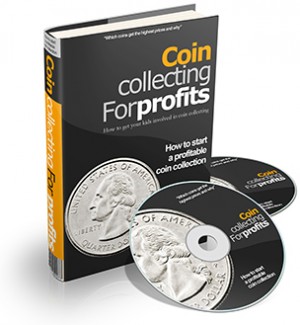 License Type: Private Label Rights
License Type: Private Label Rights  File Size: 33,972 KB
File Size: 33,972 KB File Type: ZIP
File Type: ZIP
 SKU: 52606
SKU: 52606  Shipping: Online Download
Shipping: Online Download
Ebook Sample Content Preview:
Expensive Coins
The 1804 Silver Dollar, is the King of Coins. Only 15 exist and they're in very good condition.
The 1907 ultra-high relief $20 gold piece is considered by many to be the most beautiful coin ever made. It was designed by sculptor Augustus St. Gaudens, and they're extremely scarce.
The 1913 Liberty Nickel is one of the most famous coins in the world. Thanks to its extreme rarity and a publicity campaign by one of the industry's great marketers, B. Max Mehl. It's believed the five coins were produced illegally but the government has made no attempt to confiscate them, which also adds mystery to story.
By contrast, the 1933 $20 gold piece, which currently holds the record for highest price paid at auction, is a coin that has been vigilantly hunted down and confiscated by the FBI. The lone piece that tops this chart is the sole example allowed to exist by the government, as the rest were ordered to be melted down by FDR in 1933. According to government records, none survived, and since this is the official position, the Treasury enforces it.
The sole example was given as a gift to King Farouk of Egypt, who was an avid collector. Since its return to the world, in the wake of Farouk's death, the US government has maintained the position that it is legitimate, as it was a possession of foreign royalty as a gift from the US. The spectacular sum commanded by this coin is due in part to its mysterious and intriguing history and the likelihood that it will remain unique.
The 1917 Type One Standing Liberty Quarter is one of the truly beautiful U.S. coins. It was made for only two years, because the exposed breast of Ms. Liberty caused such uproar that they changed the design halfway through 1917. Since the 1916 is a five-figure rarity, this coin is effectively a one-year-only type coin. It makes the rare coin price list thanks to its collective beauty, popularity, importance and rare top condition.
From 1795 to 1834, the U.S. minted $2.50, $5, and $10 gold coins. In 1834, the gold content of our coins was lowered slightly and most pre-1835 gold coins hit the melting pot. Today, these early treasures of American financial history are rare in all grades and super rare in Gem condition.
Today the Mint strikes millions of proof coins a year and sells them to collectors all over the world. In the 19th Century, the Mint struck a few thousand proof coins each year and only a handful of proof gold coins. Proof gold coins are the caviar of the numismatic marketplace. They are expensive, but they are super rare and demand is always sky high in both good and bad markets.
Barber Half Dollars were minted between 1892 and 1915. They are one of the coin market’s most important issues. They are collected both by date and by “type” collectors and are the rarest of the 20th Century sliver type issues.
Twenty-Cent Pieces were odd coins made for just four years from 1875 to 1878. The coin looked too much like a quarter to catch on with the public and there really wasn’t a commercial need for the denomination. Today, twenty-cent pieces are highly prized collector’s items.
Kids And Coin Collecting
Many kids start by picking up a coin they have never seen before and continue collecting. Because coin collecting requires very few supplies, it makes a great hobby for a child to start and carry with them throughout their life. Children of any age can gain knowledge from these little pieces of metal.
They can improve their reading ability.
Most general references on coins are written in fairly simple English, so children can easily understand the information. Most children improve their reading ability when reading becomes personally important to them.
It will improve their comprehension.
Coin collecting has a specialized vocabulary. Even at the entry level, the collector wants to remember many specialized terms. The moment a child realizes information is important, they will find a way to remember it.
They can hone their organizational skills.
Coin collectors are always checking references, price lists and information provided on the Internet. The collector must be organized, as information must be readily available and kept up to date.
They develop an interest in history and culture.
You can't collect coins without learning about the people who produced them. Even if a child doesn’t continue with the hobby, they will be exposed to many other interesting subjects and develop an appreciation for their importance.
The ability to set and reach goals.
Coin collectors are always making short and long term plans. Few collectors are content to have a casual assortment of coins. There is a good reason why every coin is added to the collection. Coin collectors want to build sets and acquire certain important coins. Completing a set of coins, even a small one, is seen as an important accomplishment. The collector gains a lot of satisfaction from attaining goals.
It builds self-esteem.
Perhaps the greatest benefit that coin collecting offers young people is the opportunity to legitimately participate in the adult world. There are no age restrictions and there are a number of teenagers who quickly became knowledgeable numismatists. Knowing about coins is knowledge that is appreciated by adults and the child can find themselves in a position to teach and inform adults about the hobby. Often a little success can grow into lots of ambition.
They will have to establish priorities.
Determining priorities is often difficult for children. There is so much going on and often their time and activities are planned for them. When it is their turn to decide what to do with their time, they often become bored.
Coin collecting can be a very exciting hobby. A child will want to spend time reading, learning and looking at the coins in their growing collection.
Value.
A common complaint among adults is that kids don’t understand the value of money. The moment they have money, they spend it. A young coin collector must learn to save for that special coin. They may be prompted to think of ways to earn extra money by getting better grades in school, working around the house, babysitting, or mowing the neighbor’s yard.
Getting A Child Started
Coin collecting isn’t for everyone. It takes patience, time, and an interest before the seed can be planted. However, showing your own love for the hobby is the first step toward getting young people involved.








